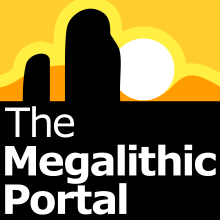Megaliths and Folklore in Brighton and Hove by Kevin Groves
The Goldstone & Hove Circle
Of the megaliths that may have once existed in the Hove area, only one small group now remains, none of which are in their original positions. In a corner of Hove Park, enclosed behind metal railings, stands the Goldstone, a sandstone/flint conglomerate, approximately 9ft high, 13ft wide and estimated to weigh around 20 tons. Around its base are grouped a further eight stones, much smaller in size than the Goldstone, which reputedly once formed part of a nearby circle.
The story of how these stones came to stand Where they do today begins back in the 1830s, when the Goldstone became something of a tourist attraction for fashionable Regency visitors to Brighton. The stone stood in Goldstone Bottom, 300 yards southwest of its present site, on land belonging to William Marsh Rigden, of Long Barn Farm. After becoming increasingly fed-up With people trampling across his fields to look at the stone, in March 1834 Rigden had it uprooted and buried (Porter 1897). This event does not seemed to have caused much concern until, over thirty years later, the historian Mark Anthony Lower came across the story and was moved to write in his History of Sussex: “a utilitarian farmer... dug a hole and buried this relic of unknown ages... some archaeologists wish he had been buried under it"
In 1898, William Hollamby of Brighton Council got to hear of this sorry tale and, on 29th September 1900, he had the Goldstone unearthed. It was re-erected in the newly-opened Hove Park in 1906.
The question of whether a stone circle ever stood near the Goldstone has been a matter of debate since it was first mentioned in 1818. In a letter to Gideon Mantel], the Rev. J. Douglas stated that: “This stone [i.e. the Goldstone] is in a line to the south of Goldstone Bottom, at the end of which, close to the rise of the hill, is a dilapidated cirque, composed of stones of the same kind”. Edwards made no mention of it in his Companion of seventeen years earlier, although he wrote in great detail about the Goldstone itself. In his 1824 Histog/ of Brighton, Sicklemore says that the stones had been “removed from their original position". This suggests that if there ever was a circle, it had been destroyed by this date (Middleton 1982), although a sketch by HG. Hines of c.1828 seems to show part of a circle still standing.
What is certain, however, is that at some time during the I840s a lot of stones were removed from this area - some were used to fill in a nearby pond, while others were allegedly broken up and taken to Brighton to become the base of the Victoria Fountain, as mentioned earlier. The reason for their removal at this time is open to question. It is unlikely that sightseers were still bothering Farmer Rigden ten years after he had disposed of the Goldstone; more likely they were considered a hindrance to farming. It fact, the noted archaeologist Herbert S. Toms was of the opinion that the 'circle' had probably been little more than a pile of clearance stones deposited there by farmers over the years. Two other suspected circles nearby (in Stanmer Park and near a farm at Standean) had, upon examination, turned out to be just that.
After his success in re-discovering the Goldstone, HoIIamby later located the site of the filled-in pond, exhumed the stones and had them placed around the larger stone, where they remain to this day.
Read more in 3rd Stone Issue 41, now available for free download - details here
https://www.megalithic.co.uk/article.php?sid=2146414673
and Issue 42 with lots more fascinating articles is available for free here
https://www.megalithic.co.uk/article.php?sid=2146414674
Something is not right. This message is just to keep things from messing up down the road
